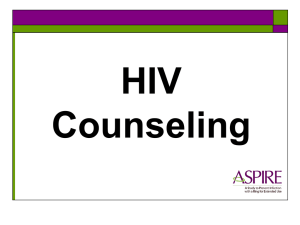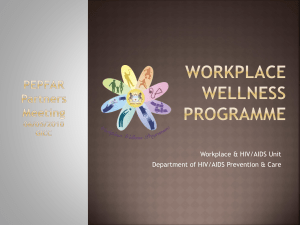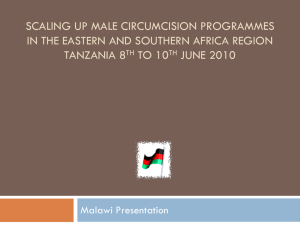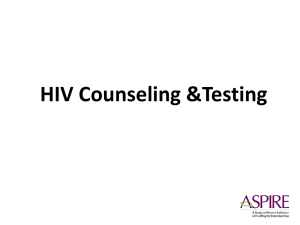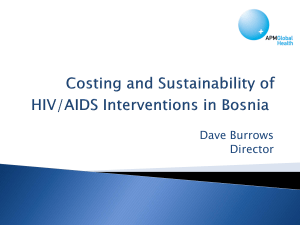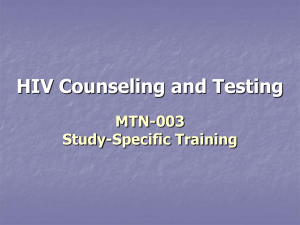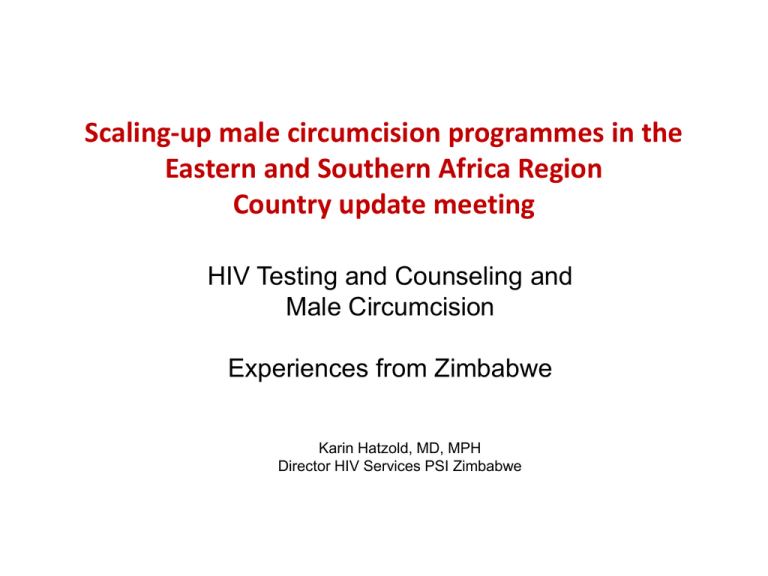
Scaling-up male circumcision programmes in the
Eastern and Southern Africa Region
Country update meeting
HIV Testing and Counseling and
Male Circumcision
Experiences from Zimbabwe
Karin Hatzold, MD, MPH
Director HIV Services PSI Zimbabwe
Issues HTC/MC
• Low uptake of HTC in several MC country programs
• Risk of increased HIV transmission if large numbers of HIV +
become circumcised and would not practice safer sex?
• T&C as “precondition” for MC might prevent uptake
because of fear of positive status
• Stigmatization of HIV + men,
who will not benefit
from the intervention?
• HIV + men might seek MC services outside clinical settings?
• Integration and linkages between HTC and MC Services
• Re-testing for HIV at MC site of previously tested individuals
T&C uptake among MC clients in
selected countries
MC Country
program
Number of
MCs
conducted
Proportion of Proportion
MC clients
circumcised
tested for HIV HIV + status
prior to
intervention
Proportion of
tested, who
tested at the
MC site
6100
89%
120, 000
56%
Namibia
350
94%
Swaziland
9309
88%
2%
98%
Tanzania
4702
99%
0.8%
100%
29, 500
62% overall,
80% in ≥16
4%
98%
6070
98%
0.5%
28%
Botswana
Kenya
Zambia
Zimbabwe
100%
3%
70%
98%
Results from Zimbabwe
MC clients by HIV testing site May09 - May2010
1200
1000
800
600
400
200
0
MCs
Tested HTC centre
Tested at MC site
Opting out of Testing
PITC and VCT in Zimbabwe
• 40% of the adult population in Zimbabwe
knows their HIV status*
• Large network of VCT services centers and
outreach teams since 1999
• PITC implemented since 2007, over 800
health care facilities are providing T&C
• High level of awareness about HTC
through Mass Media and IPC
communications
• 1 Million Zimbabweans tested per year,
35% through VCT, 65% through PITC
*Preliminary results from population based survey of 18-44 year old males and females conducted in six districts in Masvingo and Mashonaland East.
T&C as entry point for MC
• New Start nationwide network of T&C centers
and outreach teams
• Tested 1.9 Million Zimbabweans, 40, 000
monthly, 50% are men, 75% test HIV negative
• MC counseling integrated in post-test
counseling session to recruit HIV negative men
for MC at 5 pilot sites
• High uptake of MC services when offered as
additional HIV prevention intervention in
counseling session
• Booking for MC at the T&C site and referral
• Communication between T&C and MC sites
• Follow up with booked clients
Routine Offer of HIV testing
• Quality of counseling process
– Group education session
– Individual counseling session
– Counseling guides, flipcharts
• Quality of counselor
– Use of nurses & other
professionals
– Intensive Training and Refresher
Courses
– Ongoing Supervision
MC service client flow
VISIT 1
VISIT 4
VISIT 2
6-wk Review &
Reception
One-on-one
MC/ HTC
Counseling
Group
education
Routine offer
Testing
Counseling
MC Procedure
Pre-op
Assessment/
Counseling
Post-op
Recovery/
Counseling
2-day Review
&
Counseling
VISIT 3
7-day Review
&
Counseling
MC Communication messages
– Clear messaging on benefits of MC as additional
HIV prevention intervention for HIV negative men,
“primary” prevention
– T&C not mandatory, but recommended
MC and HIV + men
• In-depth counseling on known risks and benefits
of MC with HIV positive status
• If client insists on MC, clinical staging and CD4 cell
count to check medical condition
• Discussing care and treatment options with HIV
positives
–
–
–
–
Prevention and treatment of opportunistic infections
ART
Positive Living strategies
MC might not be indicated or the best option
• Provision of on-site CD4 cell count using point of
care devices
• Adequate referral into continuum of care
Acknowledgements
• MC programs in Botswana, Kenya, Namibia
Swaziland, Tanzania, Zambia
• AIDS and TB unit MOHCW Zimbabwe
• PSI New Start network
• Clients accessing T&C and MC services in
Zimbabwe
Get tested for HIV
Get circumcised



